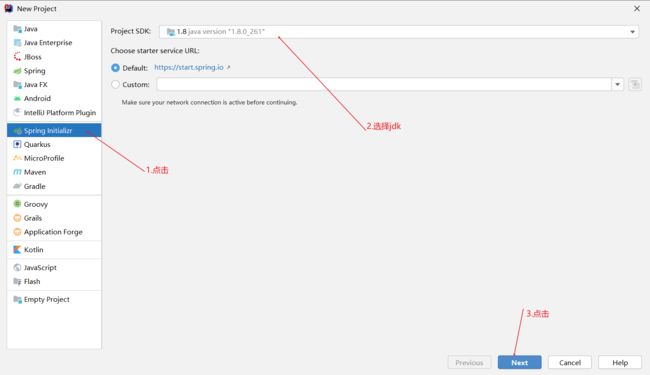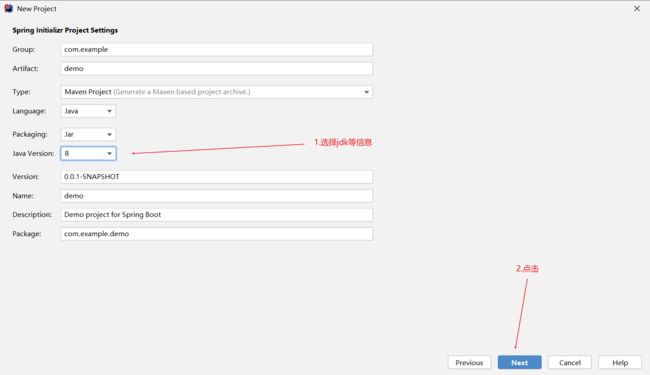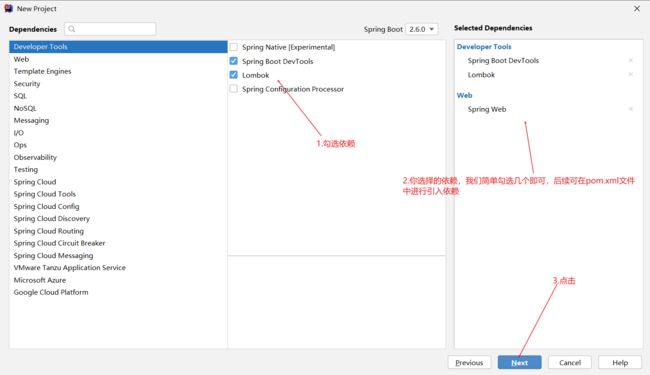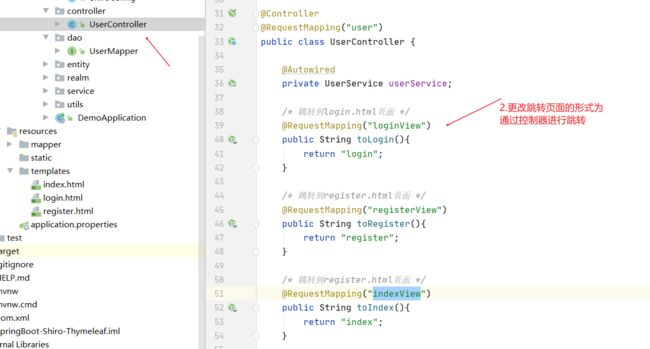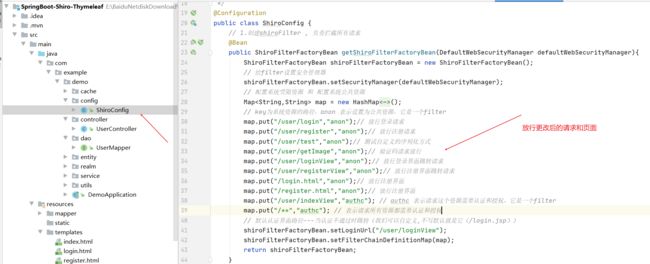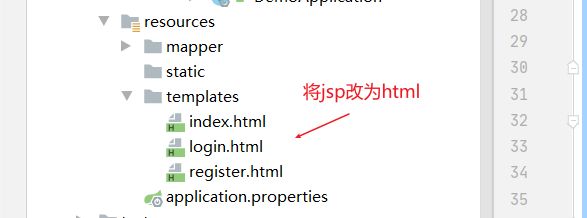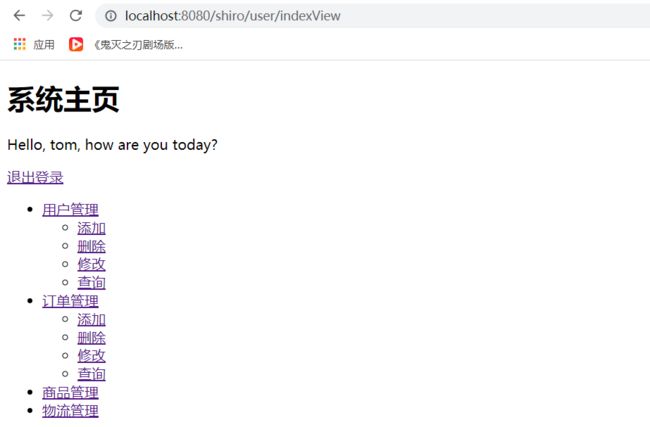SpringBoot整合Shiro学习(下)
SpringBoot整合Shiro(下)
基于【编程不良人】2020最新版Shiro教程,整合SpringBoot项目实战教程
哔哩哔哩链接:https://www.bilibili.com/video/BV1uz4y197Zm?p=1
在中篇中我们已经了解到shiro对jsp页面有很好的集成,但是与thymeleaf却没有,需要我们引入相关的依赖和配置才可以。接下来我们将学习shiro与thymeleaf的整合。
九、Shiro与thymeleaf整合
1.新建springboot项目
此处以ideal为例,我们新建一个springboot项目,
配置项目信息,
引入依赖,
对项目进行命名等配置,
2.引入依赖
创建好项目后,我们需要引入更多依赖,我们打开pom.xml文件,具体代码如下:
<project xmlns="http://maven.apache.org/POM/4.0.0" xmlns:xsi="http://www.w3.org/2001/XMLSchema-instance"
xsi:schemaLocation="http://maven.apache.org/POM/4.0.0 https://maven.apache.org/xsd/maven-4.0.0.xsd">
<modelVersion>4.0.0modelVersion>
<parent>
<groupId>org.springframework.bootgroupId>
<artifactId>spring-boot-starter-parentartifactId>
<version>2.3.2.RELEASEversion>
<relativePath/>
parent>
<groupId>com.examplegroupId>
<artifactId>demoartifactId>
<version>0.0.1-SNAPSHOTversion>
<name>demoname>
<description>Demo project for Spring Bootdescription>
<properties>
<java.version>1.8java.version>
properties>
<dependencies>
<dependency>
<groupId>org.springframework.bootgroupId>
<artifactId>spring-boot-starter-thymeleafartifactId>
dependency>
<dependency>
<groupId>com.github.theborakompanionigroupId>
<artifactId>thymeleaf-extras-shiroartifactId>
<version>2.0.0version>
dependency>
<dependency>
<groupId>org.apache.shirogroupId>
<artifactId>shiro-spring-boot-starterartifactId>
<version>1.5.3version>
dependency>
<dependency>
<groupId>org.apache.shirogroupId>
<artifactId>shiro-ehcacheartifactId>
<version>1.5.3version>
dependency>
<dependency>
<groupId>org.springframework.bootgroupId>
<artifactId>spring-boot-starter-data-redisartifactId>
dependency>
<dependency>
<groupId>com.alibabagroupId>
<artifactId>fastjsonartifactId>
<version>1.2.70version>
dependency>
<dependency>
<groupId>org.springframework.bootgroupId>
<artifactId>spring-boot-starter-webartifactId>
dependency>
<dependency>
<groupId>org.mybatis.spring.bootgroupId>
<artifactId>mybatis-spring-boot-starterartifactId>
<version>2.1.2version>
dependency>
<dependency>
<groupId>mysqlgroupId>
<artifactId>mysql-connector-javaartifactId>
<version>8.0.23version>
dependency>
<dependency>
<groupId>com.alibabagroupId>
<artifactId>druidartifactId>
<version>1.1.19version>
dependency>
<dependency>
<groupId>org.springframework.bootgroupId>
<artifactId>spring-boot-devtoolsartifactId>
<scope>runtimescope>
<optional>trueoptional>
dependency>
<dependency>
<groupId>org.projectlombokgroupId>
<artifactId>lombokartifactId>
<optional>trueoptional>
dependency>
<dependency>
<groupId>org.springframework.bootgroupId>
<artifactId>spring-boot-starter-testartifactId>
<scope>testscope>
dependency>
dependencies>
<build>
<plugins>
<plugin>
<groupId>org.springframework.bootgroupId>
<artifactId>spring-boot-maven-pluginartifactId>
<configuration>
<excludes>
<exclude>
<groupId>org.projectlombokgroupId>
<artifactId>lombokartifactId>
exclude>
excludes>
configuration>
plugin>
plugins>
build>
project>
3.书写项目配置文件
我们很多配置都是和之前一样的,此处只需要将jsp的配置改为thymeleaf的配置即可,具体如下:
server.port=8080
server.servlet.context-path=/shiro
spring.application.name=shiro
# 关闭thymeleaf的缓存,方便测试,在项目上线时需要改为true
spring.thymeleaf.cache=false
# thymeleaf的很多配置都有默认值,基本上不用我们做很多配置
spring.thymeleaf.suffix=.html
spring.thymeleaf.prefix=classpath:/templates/
spring.datasource.type=com.alibaba.druid.pool.DruidDataSource
spring.datasource.driver-class-name=com.mysql.cj.jdbc.Driver
spring.datasource.url=jdbc:mysql://localhost:3306/shiro?useUnicode=true&characterEncoding=utf8&zeroDateTimeBehavior=convertToNull&useSSL=true&serverTimezone=GMT%2B8
spring.datasource.username=root
spring.datasource.password=123456
mybatis.type-aliases-package=com.example.demo.entity
mybatis.mapper-locations=classpath:mapper/*.xml
logging.level.com.example.demo.dao=debug
4.引入之前的包
由于我们的业务都是一样的,我们将之前的项目中的代码目录复制过来更改一下即可,我们需要更改的位置如下:
1.打开UserController.java,由之前的直接跳转jsp页面更改为通过控制器进行跳转,因为thymeleaf不能直接访问视图,需要通过控制器进行访问,如果我们直接访问界面,是不能由thymeleaf进行解析的。
具体代码如下:
package com.example.demo.controller;
import com.example.demo.cache.FastJson2JsonRedisSerializer;
import com.example.demo.entity.User;
import com.example.demo.service.UserService;
import com.example.demo.utils.ApplicationContextUtils;
import com.example.demo.utils.VerifyCodeUtils;
import com.fasterxml.jackson.annotation.JsonAutoDetect;
import com.fasterxml.jackson.annotation.JsonTypeInfo;
import com.fasterxml.jackson.annotation.PropertyAccessor;
import com.fasterxml.jackson.databind.ObjectMapper;
import com.fasterxml.jackson.databind.jsontype.impl.LaissezFaireSubTypeValidator;
import org.apache.shiro.SecurityUtils;
import org.apache.shiro.authc.IncorrectCredentialsException;
import org.apache.shiro.authc.UnknownAccountException;
import org.apache.shiro.authc.UsernamePasswordToken;
import org.apache.shiro.authz.annotation.RequiresPermissions;
import org.apache.shiro.subject.Subject;
import org.springframework.beans.factory.annotation.Autowired;
import org.springframework.data.redis.core.RedisTemplate;
import org.springframework.data.redis.serializer.StringRedisSerializer;
import org.springframework.stereotype.Controller;
import org.springframework.web.bind.annotation.RequestMapping;
import org.springframework.web.bind.annotation.ResponseBody;
import javax.servlet.ServletOutputStream;
import javax.servlet.http.HttpServletResponse;
import javax.servlet.http.HttpSession;
import java.io.IOException;
@Controller
@RequestMapping("user")
public class UserController {
@Autowired
private UserService userService;
/* 跳转到login.html页面 */
@RequestMapping("loginView")
public String toLogin(){
return "login";
}
/* 跳转到register.html页面 */
@RequestMapping("registerView")
public String toRegister(){
return "register";
}
/* 跳转到register.html页面 */
@RequestMapping("indexView")
public String toIndex(){
return "index";
}
/**
* 测试我们自定义的序列化方式
*/
@RequestMapping("test")
@ResponseBody
public String test() {
RedisTemplate redisTemplate = (RedisTemplate) ApplicationContextUtils.getBean("redisTemplate");
System.out.println(redisTemplate);
/* 序列化key的序列化方式为string类型的序列化方式 */
redisTemplate.setKeySerializer(new StringRedisSerializer());
// 使用Jackson2JsonRedisSerializer来序列化和反序列化redis的value值
// Jackson2JsonRedisSerializer serializer = new Jackson2JsonRedisSerializer(Object.class);
// 使用Fastjson2JsonRedisSerializer来序列化和反序列化redis的value值
FastJson2JsonRedisSerializer serializer = new FastJson2JsonRedisSerializer(Object.class);
// Jackson之ObjectMapper对象的使用: https://blog.csdn.net/qq_41834086/article/details/111152470
ObjectMapper mapper = new ObjectMapper();
// ALL:此伪类型表明所有访问器都受到影响。ANY:所有类型的访问修饰符都是可接受的,从私有到公有。
mapper.setVisibility(PropertyAccessor.ALL, JsonAutoDetect.Visibility.ANY);
mapper.activateDefaultTyping(LaissezFaireSubTypeValidator.instance, ObjectMapper.DefaultTyping.NON_FINAL, JsonTypeInfo.As.PROPERTY);
serializer.setObjectMapper(mapper);
// 使用Jackson2JsonRedisSerializerr来序列化和反序列化redis的value值
redisTemplate.setValueSerializer(serializer);
/* 查询tom的数据 */
User tom = userService.findByUserName("tom");
redisTemplate.opsForValue().set("123",tom);
return "ok";
}
/**
* 退出登录
*/
@RequestMapping("logout")
public String logout() {
Subject subject = SecurityUtils.getSubject();
subject.logout();//退出用户
return "redirect:/user/loginView";
}
/**
* 用来处理身份认证
* @param username
* @param password
* @return
*/
@RequestMapping("login")
public String login(String username, String password, String code, HttpSession session) {
//比较验证码
String codes = (String) session.getAttribute("code");
try {
/* 在web环境中,只要我们在ShiroConfig配置中创建了安全管理器,shiro就会自动给SecurityUtils注入web的安全管理器,
即注入DefaultWebSecurityManager*/
// 获取主体对象
if (codes.equalsIgnoreCase(code)) {
Subject subject = SecurityUtils.getSubject();
// 在认证过程中使用subject.login进行认证, UsernamePasswordToken将用户名密码封装为token
subject.login(new UsernamePasswordToken(username, password));
return "redirect:/user/indexView";
}else {
throw new RuntimeException("验证码错误!");
}
} catch (UnknownAccountException e) {
e.printStackTrace();
System.out.println("用户名错误!");
} catch (IncorrectCredentialsException e) {
e.printStackTrace();
System.out.println("密码错误!");
} catch (Exception e) {
e.printStackTrace();
System.out.println(e.getMessage());
}
return "redirect:/user/loginView";
}
/**
* 用户注册
*/
@RequestMapping("register")
public String register(User user) {
try {
userService.register(user);
return "redirect:/user/loginView";
}catch (Exception e){
e.printStackTrace();
return "redirect:/user/registerView";
}
}
/* 基于授权的代码方式测试 */
@RequestMapping("save")
public String save(){
//基于角色
//获取主体对象
Subject subject = SecurityUtils.getSubject();
//代码方式
if (subject.hasRole("admin")) {
System.out.println("有admin角色!");
}else{
System.out.println("无admin角色!");
}
//基于权限字符串
/*
* isPermitted() 方法判断这个登录的用户是否具有参数字符串所表示的权限,返回一个 boolean 类型的值。
* checkPermission() 和 isPermitted() 方法的功能是类似的,区别在于如果这个登录的用户不具有参数字符串所表示的权限时,程序将抛出异常。
* 类似地,hasRole() 和 checkRole() 方法也有类似的作用,在这里就不多做解释了。
* */
if (subject.isPermittedAll("user:*")){
System.out.println("拥有user:*权限");
}else {
System.out.println("没有user:*权限");
}
return "redirect:/user/indexView";
}
/* 基于授权的注解方式测试 */
@RequestMapping("save2")
// @RequiresRoles(value={"admin","user"})//用来判断角色,这里表示同时具有 admin user 角色才能进行此方法
// 用来判断权限字符串,这里表示user:update:01才能进入此方法(如果是user:*:*(可以简写为user:*)或者*:*:*(全部角色)也可进入此方法)
@RequiresPermissions("user:update:01")
public String save2(){
System.out.println("进入了此方法");
return "redirect:/user/indexView";
}
/* 生成验证码 */
@RequestMapping("getImage")
public void getImage(HttpSession session, HttpServletResponse response) throws IOException {
// 生成4位验证码
String code = VerifyCodeUtils.generateVerifyCode(4);
// 验证码放入session
session.setAttribute("code",code);
// 以response响应流的形式将验证码存入图片
ServletOutputStream os = response.getOutputStream(); // 拿到响应流
// 给响应流设置响应类型
response.setContentType("image/png");
VerifyCodeUtils.outputImage(220, 60, os, code);
}
}
2.修改shiro配置
我们打开ShiroConfig.java文件,放行UserController.java更改后的请求和界面
具体代码如下:
package com.example.demo.config;
import at.pollux.thymeleaf.shiro.dialect.ShiroDialect;
import com.example.demo.cache.RedisCacheManager;
import com.example.demo.realm.CustomerRealm;
import org.apache.shiro.authc.credential.HashedCredentialsMatcher;
import org.apache.shiro.realm.Realm;
import org.apache.shiro.spring.web.ShiroFilterFactoryBean;
import org.apache.shiro.web.mgt.DefaultWebSecurityManager;
import org.springframework.context.annotation.Bean;
import org.springframework.context.annotation.Configuration;
import java.util.HashMap;
import java.util.Map;
/**
* 用来整合shiro框架相关的配置类
*/
@Configuration
public class ShiroConfig {
// 1.创建shiroFilter , 负责拦截所有请求
@Bean
public ShiroFilterFactoryBean getShiroFilterFactoryBean(DefaultWebSecurityManager defaultWebSecurityManager){
ShiroFilterFactoryBean shiroFilterFactoryBean = new ShiroFilterFactoryBean();
// 给filter设置安全管理器
shiroFilterFactoryBean.setSecurityManager(defaultWebSecurityManager);
// 配置系统受限资源 和 配置系统公共资源
Map<String,String> map = new HashMap<String,String>();
// key为系统资源的路径,anon 表示设置为公共资源,它是一个filter
map.put("/user/login","anon");// 放行登录请求
map.put("/user/register","anon");// 放行注册请求
map.put("/user/test","anon");// 测试自定义的序列化方式
map.put("/user/getImage","anon");// 验证码请求放行
map.put("/user/loginView","anon");// 放行登录界面跳转请求
map.put("/user/registerView","anon");// 放行注册界面跳转请求
map.put("/login.html","anon");// 放行注册界面
map.put("/register.html","anon");// 放行注册界面
map.put("/user/indexView","authc"); // authc 表示请求这个资源需要认证和授权,它是一个filter
map.put("/**","authc"); // 表示请求所有资源都需要认证和授权
// 默认认证界面路径---当认证不通过时跳转(我们可以自定义,不写默认就是它(/login.jsp))
shiroFilterFactoryBean.setLoginUrl("/user/loginView");
shiroFilterFactoryBean.setFilterChainDefinitionMap(map);
return shiroFilterFactoryBean;
}
// 2.创建安全管理器,此处使用DefaultWebSecurityManager,我们之前使用的DefaultSecurityManager不具有web容器的特性
@Bean
public DefaultWebSecurityManager getDefaultWebSecurityManager(Realm realm){
DefaultWebSecurityManager defaultWebSecurityManager = new DefaultWebSecurityManager();
//给安全管理器设置
defaultWebSecurityManager.setRealm(realm);
return defaultWebSecurityManager;
}
// 3.创建自定义realm
@Bean("realm")
public Realm getRealm(){
CustomerRealm customerRealm = new CustomerRealm();
// 设置hashed凭证匹配器
HashedCredentialsMatcher credentialsMatcher = new HashedCredentialsMatcher();
// 设置md5加密
credentialsMatcher.setHashAlgorithmName("md5");
// 设置散列次数
credentialsMatcher.setHashIterations(1024);
customerRealm.setCredentialsMatcher(credentialsMatcher);
// 开启缓存管理器
customerRealm.setCacheManager(new RedisCacheManager()); // 使用自定义的RedisCacheManager缓存的实现
customerRealm.setCachingEnabled(true);// 开启全局的缓存管理
customerRealm.setAuthenticationCachingEnabled(true);// 开启认证的缓存管理
// 给认证的缓存在内存中起名字,不写则默认为“包名+authenticationCache“,如此处为com.example.demo.realm.CustomerRealm.authenticationCache
customerRealm.setAuthenticationCacheName("authenticationCache");
customerRealm.setAuthorizationCachingEnabled(true);// 开启授权的缓存管理
// 给授权的缓存在内存中起名字,不写则默认为“包名+authorizationCache“,如此处为com.example.demo.realm.CustomerRealm.authorizationCache
customerRealm.setAuthorizationCacheName("authorizationCache");
return customerRealm;
}
/* 加入shiro的方言,解决shiro与thymeleaf整合页面中的标签不生效的原因 */
@Bean(name = "shiroDialect")
public ShiroDialect shiroDialect(){
return new ShiroDialect();
}
}
3.将jsp页面更改为html页面,此处需要注意的是我们需要引入thymeleaf和shiro的命名空间,即
<html xmlns="http://www.w3.org/1999/xhtml" xmlns:th="http://www.thymeleaf.org"
xmlns:shiro="http://www.pollix.at/thymeleaf/shiro">
此处我们先扩展shiro与thymeleaf整合常见权限控制标签使用:
5.常见权限控制标签使用
<p shiro:guest="">Please <a href="login.html">logina>p>
<p shiro:user="">
Welcome back John! Not John? Click <a href="login.html">herea> to login.
p>
<p shiro:authenticated="">
Hello, <span shiro:principal="">span>, how are you today?
p>
<a shiro:authenticated="" href="updateAccount.html">Update your contact informationa>
<p>Hello, <shiro:principal/>, how are you today?p>
<p shiro:notAuthenticated="">
Please <a href="login.html">logina> in order to update your credit card information.
p>
<a shiro:hasRole="admin" href="admin.html">Administer the systema>
<p shiro:lacksRole="developer">
Sorry, you are not allowed to developer the system.
p>
<p shiro:hasAllRoles="developer, 2">
You are a developer and a admin.
p>
<p shiro:hasAnyRoles="admin, vip, developer,1">
You are a admin, vip, or developer.
p>
<a shiro:hasPermission="userInfo:add" href="createUser.html">添加用户a>
<p shiro:lacksPermission="userInfo:del">
Sorry, you are not allowed to delete user accounts.
p>
<p shiro:hasAllPermissions="userInfo:view, userInfo:add">
You can see or add users.
p>
<p shiro:hasAnyPermissions="userInfo:view, userInfo:del">
You can see or delete users.
p>
<a shiro:hasPermission="pp" href="createUser.html">Create a new Usera>
了解了之后,我们书写代码,具体代码如下:
index.html
DOCTYPE html>
<html xmlns="http://www.w3.org/1999/xhtml" xmlns:th="http://www.thymeleaf.org"
xmlns:shiro="http://www.pollix.at/thymeleaf/shiro">
<head>
<meta charset="UTF-8">
<meta name="viewport"
content="width=device-width, user-scalable=no, initial-scale=1.0, maximum-scale=1.0, minimum-scale=1.0">
<meta http-equiv="X-UA-Compatible" content="ie=edge">
<title>主页title>
head>
<body>
<h1>系统主页h1>
<p>Hello, <shiro:principal/>, how are you today?p>
<a th:href="@{/user/logout}">退出登录a>
<ul>
<shiro:hasAnyRoles name="user_manager,admin,addinfo_manager">
<li><a href="">用户管理a>
<ul>
<shiro:hasPermission name="user:add:*">
<li><a href="">添加a>li>
shiro:hasPermission>
<shiro:hasPermission name="user:delete:*">
<li><a href="">删除a>li>
shiro:hasPermission>
<shiro:hasPermission name="user:update:*">
<li><a href="">修改a>li>
shiro:hasPermission>
<shiro:hasPermission name="user:find:*">
<li><a href="">查询a>li>
shiro:hasPermission>
ul>
li>
shiro:hasAnyRoles>
<shiro:hasAnyRoles name="order_manager,admin,addinfo_manager">
<li><a href="">订单管理a>li>
<ul>
<shiro:hasPermission name="order:add:*">
<li><a href="">添加a>li>
shiro:hasPermission>
<shiro:hasPermission name="order:delete:*">
<li><a href="">删除a>li>
shiro:hasPermission>
<shiro:hasPermission name="order:update:*">
<li><a href="">修改a>li>
shiro:hasPermission>
<shiro:hasPermission name="order:find:*">
<li><a href="">查询a>li>
shiro:hasPermission>
ul>
shiro:hasAnyRoles>
<shiro:hasRole name="admin">
<li><a href="">商品管理a>li>
<li><a href="">物流管理a>li>
shiro:hasRole>
<shiro:hasRole name="user">
<li><a href="">仅普通用户可见a>li>
<li><a href="">公共资源a>li>
shiro:hasRole>
ul>
body>
html>
login.html
DOCTYPE html>
<html xmlns="http://www.w3.org/1999/xhtml" xmlns:th="http://www.thymeleaf.org"
xmlns:shiro="http://www.pollix.at/thymeleaf/shiro">
<head>
<meta charset="UTF-8">
<title>Titletitle>
head>
<body>
<h1>登录界面h1>
<form th:action="@{/user/login}" method="post">
用户名:<input type="text" name="username"> <br/>
密 码 : <input type="text" name="password"> <br>
请输入验证码: <input type="text" name="code"><img th:src="@{/user/getImage}" alt=""><br>
<input type="submit" value="登录"><br>
<a th:href="@{/user/registerView}">前往注册a>
form>
body>
html>
register.html
DOCTYPE html>
<html xmlns="http://www.w3.org/1999/xhtml" xmlns:th="http://www.thymeleaf.org"
xmlns:shiro="http://www.pollix.at/thymeleaf/shiro">
<head>
<meta charset="UTF-8">
<title>Titletitle>
head>
<body>
<h1>注册界面h1>
<form th:action="@{/user/register}" method="post">
用户名:<input type="text" name="username"> <br/>
密 码 : <input type="text" name="password"> <br/>
<input type="submit" value="立即注册"><br/>
<a th:href="@{/user/loginView}">返回登录a>
form>
body>
html>
6.加入shiro的方言配置
-
页面标签不起作用一定要记住加入方言处理
-
之后我们还要引入shiro的方言配置,因为thymeleaf与shiro结合后默认是没有解析shiro的方言的,所以页面上的shiro页面标签不起作用,我们打开ShiroConfig.java文件,加入以下代码,
/* 加入shiro的方言,解决shiro与thymeleaf整合页面中的标签不生效的原因 */
@Bean(name = "shiroDialect")
public ShiroDialect shiroDialect(){
return new ShiroDialect();
}
重启项目,进行登录,登录成功。
源码获取
至此,我们的SpringBoot整合Shiro学习(下)就讲解完成了。源码和数据库文件可以通过关注我的微信公众号 我爱学习呀嘻嘻 ,回复关键字shiro集成进行获取哦。
SpringBoot整合Shiro学习(上):Shiro基础知识
SpringBoot整合Shiro学习(中):Shiro与Jsp页面整合
![]()
